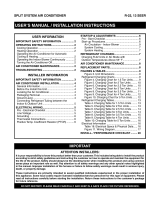
2
SECTION 1. OWNER
INFORMATION
OPERATING INSTRUCTIONS
To Turn On Air Conditioner
1. Set the system switch to "Cool."
2. Set the thermostat at the temperature level
you desire.
3. Your air conditioner should start as soon as
room temperature rises above the setting
on the thermostat.
To Shut Off Air Conditioner
1. Turn the system switch to "Heat" or "Off."
2. Turn the thermostat to the desired heating
temperature setting.
BEFORE YOU CALL A SERVICEMAN
Check your system at the start of each air
conditioning season. Make sure it's working
right, clean or change filters and make any
needed adjustments.
In addition, follow these simple rules:
1. Never run your system without a filter. If
you do, the cooling coils will collect dirt and
may become clogged.
2. Set your thermostat at the comfort level
you wish -- and then leave it alone. Let it
control the operation of the air conditioning
system. If you get chilly, turn it up a degree
at a time until comfort is restored.
3. It takes longer for an air conditioner to cool
your dwelling than it does for your furnace
to heat it. So . . . don't turn the unit on and
expect a dramatic drop in temperature, at
least not right away. If your home is hot and
humid, the temperature will drop slowly.
4. Check your filters every 30 days in sum-
mer to see if they are dirty. To keep them
clean, use a mild solution of detergent and
water on washable types. Replace non
washable filters.
5. Keep your outdoor condenser coil clean.
You can hose it down when it gets dirty.
If your air conditioner isn't working:
1. Make sure the fuses are not blown or that
your circuit breakers are on.
2. See that your thermostat is set at the
desired temperature and that your system's
switch is on "Cool."
3. For best air flow, make sure your return
grille is not covered and that the filter is
clean.
4. Check the outdoor condenser coil and
make sure it is clean and not clogged with
grass or leaves.
If your air conditioner still isn't working, call your
nearest distributor.
SECTION 2. INSTALLER
INFORMATION
GENERAL
Read the following instructions completely
before performing the installation.
These instructions are for the use of qualified
personnel specially trained and experienced in
the installation of this type of equipment and
related system components. Some states re-
quire installation and service personnel to be
licensed. Unqualified individuals should not
attempt to interpret these instructions or install
this equipment.
The single packaged air conditioners are de-
signed for outdoor installation only and can be
readily connected into the high static duct
system of a home. The only connections
needed for installation are the supply and return
ducts, the line voltage, and thermostat wiring.
The single package air conditioner is com-
pletely assembled, factory wired, and factory
run tested. The units are ready for easy and
immediate installation.
PRE-INSTALLATION CHECK
Before any installation is attempted, the cooling
load of the area to be conditioned must be
calculated and a system of the proper capacity
selected. It is recommended that the area to be
conditioned be completely insulated and vapor
sealed.
The installer should comply with all local codes
and regulations which govern the installation of
this type of equipment. Local codes and regu-
lations take precedence over any recommen-
dations contained in these instructions. Consult
local building codes and the National Electrical
Code (ANSI CI) for special installation require-
ments.












